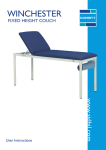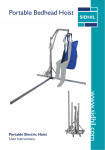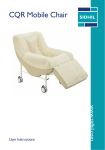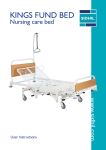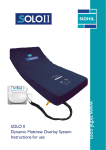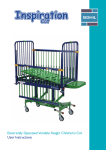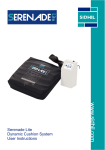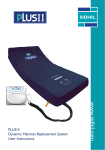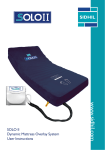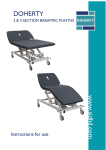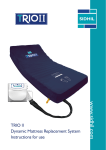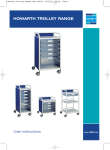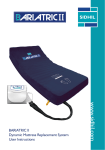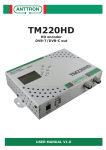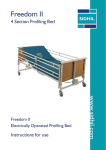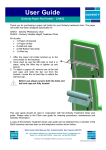Download Inspiration User Guide
Transcript
Independence User Instructions www.sidhil.com Independence Innov8 Electrically Operated Profiling Bed Section Title 1 1.1 1.2 2 2.1 2.2 3 4 5 5.1 5.2 5.2.1 5.2.2 5.3 5.3.1 5.3.2 5.3.3 5.4 5.5 5.6 5.7 6 6.1 6.1.1 6.1.2 6.2 6.3 7 7.1 7.2 8 8.1 8.2 8.3 9 9.1 9.2 10 11 Introduction Features Warning and Cautions Clinical Use Typical Use Risk Assessment Symbol Definition Installation Manual Operation of the Bed General Safety Brake & Steer System Pedal Operation Moving the Bed Side Rails Mattress Thicknesses Operating the Side Rails Operating the Split Side Rails Bed Extension Bed Stripper Emergency CPR Function – Manual Bed Ends Electrical Operation of the Bed Nurse Control Panel Nurse Control Panel Features Operating the Nurse Control Panel Patient Handset Night Pack Decontamination Biocote Cleaning & Disinfection Guidelines Maintenance Fault Finding Resetting / Intialising the Electrical System General Maintenance Specification Bed Data Electrical Data Accessories Warranty Page 1 1 1 2 2 2 3 4 5 5 5 5 6 6 7 8 9 10 11 12 13 14 14 14 15 18 19 20 20 20 21 22 22 23 24 24 25 25 26 1. Introduction Thank you for purchasing A Sidhil Independence Innov8 Bed. This user manual should be read carefully before operating the bed. Please ensure that you understand all instructions, if you have any questions concerning the operation or maintenance of the bed please contact Sidhil Ltd. 1.1 Features • • • • • • • • • • • • • • Electrically operated backrest, height and knee break angle Auto regressing backrest Infinitely variable electrically operated head and foot down tilt (Trendelenburg & reverse Trendelenburg) Auto contour – simultaneous adjustment of the backrest and knee-break Auto cardiac chair position Battery backup Patient handset and nurse control panel with integral function lockout Removable head and foot ends Removable plastic mattress platform panels Mattress platform extension Pull out bed stripper Integral side rails* X-ray translucent backrest with cassette tray* Oxygen cylinder carrier* * Feature availability is dependent on the bed model 1.2 Warnings and Cautions Warnings in this user manual highlight potential hazards that if disregarded could lead to injury or death. Cautions in this user manual highlight potential hazards that if disregarded could lead to equipment damage or failure. 1 2. Clinical Use 2.1 Typical Use The Innov8 bed range covers every need from a utility ward bed to high dependency, where patients whose clinical requirements and situation of care require positioning with minimal handling. At the carer’s discretion patients can use the controls to adjust the bed to their preferred position. 2.2 Risk Assessment Before a patient uses the bed a risk assessment must be performed on a patient by patient basis. The risk assessment should include, but is not limited to: • • • • Entrapment Falling out of the bed Small children (and adults) Patients with learning difficulties The safe working load of the bed is: The maximum user weight of the bed is: 255kg (40 stone) 220kg (35 stone) Bed functions must be locked out if there is any doubt about the ability of the patient operating the bed safely. Warning Misused electrical equipment can be hazardous. Accessories that have not been approved or designed for use with the bed should not be used. Electrically operated beds should not be used in the presence of Warning flammable gasses. Electrically operated beds should not be used in operating theatres. Ensure cables are kept away from moving parts of the bed, to avoid damage to the bed and / or cabling. Caution 2 3. Symbol Definition The following symbols are found on the bed: Warning Refer to user guide Safe working load Maximum user weight Place of manufacture W.E.E.E Label (Do not disgard in general waste, follow local recycling policy) 3 4. Installation Prior to operating the bed for the first time the following simple checks must be performed: • • • • Ensure the bed (and all accessories) is at room temperature Ensure the bed has been cleaned and disinfected (page 19) Connect the mains cable to an appropriate mains socket outlet Using the nurse control panel, raise the mattress platform to its maximum height to ensure the bed is level (page 14) If the electrical functions are not active it will be for one of two reasons: 1. Functions have been locked out on the nurse control panel, see page 14 for activation. 2. The electrical system needs initialising, see page 21 for the procedure. Ensure the orange coiled mains cable is not in tension when connected to the mains supply. Ensure that cables and handsets are clear of all moving parts to prevent damage to the electrical components. Warning Special care should be taken when fitting an air mattress to the bed as incorrect fitting could damage the bed. 4 5. Manual Operation of the Bed 5.1 General Safety • When the bed is operated, ensure that obstacles such as over-bed tables and other furniture are not causing an obstruction. • Ensure the electrical cables are not in tension. • Ensure that any mattresses used are of the correct size and type and have been fitted correctly. A range of suitable pressure relieving and pressure reducing mattresses are available from Sidhil Ltd. • Before operating the bed ensure the patient is positioned appropriately. • When a patient is left unattended ensure the bed is set at its minimum height. 5.2 Brake & Steering System 5.2.1 Pedal Operation There are two linked brake pedals at the foot end of the bed which operate the castors simultaneously. Each pedal has a red and green end. • Green end down (steer): One castor is locked, allowing the bed to be steered from the head end of the bed. • Pedal horizontal (free): No locked castors, allowing all to swivel freely. • Red end down (brake): Three castors are locked, the bed cannot move. Steer Free Brake The brake must always be engaged when the bed is stationary. Warning 5 5.2.2 Moving the Bed Before moving the bed the following checks must be performed: • • • • Side rails must be raised if there is a patient in the bed, to minimise the risk of falling. The platform must be horizontal. The platform must be raised/lowered to a suitable height for pushing. The mains lead must be unplugged and stored on the cable tidy hooks If the bed is to be pushed up/down a slope it is advised that two people move the bed, with one person at each end. Warning If the bed is to be pushed with a heavy load it should be assessed whether or not two people should move the bed, this is dependent on the situation and load on the bed. 5.3 Side Rails The Innov8 bed range can be specified with three different types of side rail, this is to provide the optimum mattress/side rail combination for both foam and air mattresses of varying thicknesses. When specifying a mattress and side rail combination a clinical assessment of the patient’s needs must be carried out in line with the local policy. 6 5.3.1 Mattress Thicknesses Standard, 3 bar, cantilever side rail = 158mm maximum mattress thickness High, 4 bar, cantilever side rail = 270mm maximum mattress thickness Split side rail = 152mm maximum mattress thickness If an overlay air mattress is used it may be necessary to use a thinner foam mattress for the combined height to maintain the 270mm dimension, when using the high side rail. Refer to MHRA Device Bulletin DB2006 (06) ‘Safe use of bed rails’. Side rails pose a potential entrapment hazard, please refer to the side rail safety notice, SR/PSN 01/01/1, supplied with this product. Side rails must only be used with a mattress of the correct size and type that is approved for use with the Innov8 bed. Ensure the side rails are locked in place at all times when in the raised position. A risk assessment should be carried out to consider the age, condition and size of the patient to assess the suitability of side rails. Warning Side rails are not designed to act as restraints for patients. Side rails are not designed to be used as a patient lifting aid. Do not use the side rails to move the bed. Caution 7 5.3.2 Operating the Cantilever Side Rails To lower: Hold the top rail and pull out the release plunger. Gently lower the side rail towards the foot end of the bed. To raise: Hold the top rail and lift the side rail until it locks into the vertical position. Ensure the side rail release plunger is fully engaged when the side rails are in the raised position. Warning When operating the side rails ensure they are free from obstructions, to prevent injury/entrapment. When lowering do not drop the rail, damaged could be caused. Caution 8 5.3.3 Operating the split side rails To lower: Support the side rail at the top of the forming and pull the green release handle. Gently lower the side rail towards the floor and release once it has travelled more than 90° through its range of movement. To raise: Hold the side rail at any point along the length of the forming, raise component until the lock pins engage into position. Ensure the side rail lock pins have fully engaged when the side rails are in the raised position. When operating the side rails ensure they are free from Warning obstructions, to prevent injury/entrapment. When lowering do not drop the rail, as damage could be caused. Caution 9 5.4 Bed Extension The bed comes with an integral bed extension which allows the bed to be adjusted in length, according to the patients needs. To extend: • If the bed is in tilt the platform must be levelled first (see page 15). • Pull out the spring loaded plunger located on the side of the bed near the foot end, whilst holding out rotate by a quarter turn (the plunger should stay out). Repeat for the plunger on the opposite side of the bed. • Pull out the mattress platform extension to its maximum extent. • Rotate the spring loaded plungers until they lock back into position. • Press down on the catch located at the foot end of the leg extension. • Pull out the leg extension to its maximum extent. 10 To retract: • Push in the leg extension until it re-engages with the catch. • Pull out the spring loaded plunger located on the side of the bed near the foot end, whilst holding out rotate by a quarter turn (the plunger should stay out). Repeat for the plunger on the opposite side of the bed. • Push the mattress platform extension fully in. • Rotate the spring loaded plungers until they lock back into position. Never pull the leg extension out without the mattress platform extension pulled out. Always fit a mattress extension block when the platform is extended. Warning Always ensure the extension is locked in position, both in the extended & retracted state. 5.5 Bed Stripper An integral extending bed stripper is incorporated into the foot end of the bed to assist with linen changing procedures. To use the bed stripper pull it out to its full extent. After use, push the bed stripper fully in. The safe working load of the bed stripper is 20kg. Warning 11 5.6 Emergency CPR Function - Manual The backrest and knee break can be levelled simultaneously via the manual CPR handles located on both sides of the bed. To flatten the platform in an emergency, pull one of the red handles outwards. The backrest and knee break will drop into a flattened state. Note: The platform will not level itself or change height when the manual handles are pulled, this function is only available with the electrical CPR function. The backrest and knee break may fall quickly, ensure that limbs and equipment are clear. Warning 12 5.7 Bed Ends The bed has plastic end panels which are easily removable, allowing for fast patient access. To remove, hold the panel with both hands and lift squarely. 13 6. Electrical Operation of the Bed 6.1 Nurse Control Panel The nurse control panel (NCP) controls all bed functionality; it is to be used only by the carer. The NCP is designed to be stored on the end of the bed by clipping it over the bed end panel. 6.1.1 Nurse Control Panel Features Backrest Platform height Auto contour Knee break Tilt Cardiac chair Direction buttons Function lock button CPR button 14 6.1.2 Operating the Nurse Control Panel Adjusting the platform: Green light = Function active To activate a function, press the desired function button. A green light will illuminate at the top of the function button, this indicates that the function is now active. Once the function button is active hold down one of the direction keys, until the required position is reached. Note: The function will stay active for 5 seconds. If after 5 seconds a direction button has not been pressed the function will de-activate and the green light will go out. Disabling / enabling bed functions: To lockout a function one of the padlock symbols must be pressed simultaneously with the function required for lockout. An amber light will illuminate at the bottom of the function button, this indicates the fact that the function is now locked out. Amber light = Function locked To unlock a function the above process is repeated, the amber light will extinguish. Note: When a function is locked out on the NCP, the patient handset (see page 17) will have the corresponding function locked out. Knee break: The knee break button on the NCP allows adjustment of the thigh section angle. Adjusting the height of the foot section requires a manual operation: • • • • Lift the leg section. Lift the leg stay bar. Position the leg stay into the channel. The knee break button on the NCP will now raise/lower the leg section. 15 Leg section height adjustment Thigh section angle adjustment Auto contour: When the auto contour button is pressed both the backrest and knee break functions operate together. Note: The operation of the knee break section will vary dependent on the position of the leg stay bar as detailed above. Note: If the backrest or knee break are locked out this will automatically disable the auto contour function. Tilt: Head down tilt (Trendelenburg) and foot down tilt can be applied using the nurse control panel. When in tilt, in order to level the bed the opposite direction button should be pressed and held until the bed stops, the platform will now be level (Note: it may be necessary to re-activate the tilt function). To continue tilting the bed in the opposite direction, re-press the same direction button again and hold until the desired angle is reached. 16 When the bed is put into head down tilt there must be sufficient space behind the bed to ensure the head board and/or any ancillary equipment cannot clash with the wall. Caution Cardiac Chair: Green lights = Function active The bed can be automatically profiled into a cardiac chair position, where the platform is automatically profiled into the auto contour position and then moves into foot down tilt. When the auto contour and tilt buttons are pressed within 5 seconds of each other, this automatically enables the cardiac chair function. Pressing either one of the two ‘up’ buttons orientates the bed into the cardiac chair position. Pressing either one of the two ‘down’ buttons takes the bed out of cardiac chair and levels the platform. Electrical CPR: Pressing the CPR button automatically levels, flattens and lowers the platform, once the platform is at its minimum height it then drives up to maximum height. Regardless of position the backrest always lowers first (if raised), so that it is flat in the quickest possible time. Note: Pressing the CPR function overrides all locked out functions. The mechanical CPR function will flatten the platform quicker than the electrical CPR, but will not level or lower the platform. Warning Mains Power Indicator: The nurse control panel has a mains power light in the top left corner. If it is not lit amber, the bed is either unplugged or has a fault (see page 21). 17 Battery Indicator: The nurse control panel has a battery light that shows when the battery is charging. Note: It does not indicate when the bed is being run off battery power. When the bed is running off battery power and the batteries are almost flat an audible alarm will be heard when a handset button is pressed. The bed is not designed to run off battery power for long periods and should always be plugged into the mains supply during normal use. Caution 6.2 Patient Handset The patient handset is designed to give limited control to the occupant. It allows control of: Backrest angle Platform height Auto contour (backrest and knee break profiled together) Note: If functions have been locked out on the nurse control panel the same functions will be locked out on the patient handset. 18 6.3 Night Pack (Optional accessory) Along with the functions of the standard patient handset, the night pack handset is back lit and controls an under bed light. When any button on the handset is pressed all functions light up and stay lit whilst the handset is in use or for 10 seconds if inactive. When the under bed light button is pressed it operates a light on both sides of the platform, providing a small pool of light either side of the bed. Under bed light button 19 7. Decontamination 7.1 Biocote Infection control and routine cleaning must be carried out in accordance with your local Infection control policy or regulatory body. The bed comes with an antibacterial additive incorporated into the powder coated metalwork. Biocote® inhibits the growth of bacteria on the surface of the bed frame. It is effective against a wide range of both gram positive and negative bacteria as well as fungi. Examples of bacteria that Biocote® is resistant to include: • • • • • • Bacillus Subtilis Staphylococcus Aureus (MRSA) Escerichia Coli 0157 Streptococcus Faecalis Salmonella Enteritides Listeria Monocytogenes Biocote® is an aid to keeping your bed infection free but it does not substitute the need for the bed to be cleaned at regular intervals. Warning 7.2 Cleaning & Disinfection Guidelines Always disconnect the bed from the main power supply prior to cleaning. Warning To aid cleaning, the plastic bed ends and mattress platform panels can be removed. It is also advisable to remove any accessories that are fastened to the bed. These instructions apply to all accessories apart from soft products (e.g. mattresses). 20 • All surfaces to be wiped down with a disposable soft cloth moistened with a mild detergent and diluted in warm water (40°C). • The bed should be cleaned by starting with the cleanest parts of the bed and systematically moving to the dirtiest parts. Extra care should be taken around areas where excess dirt or dust may gather. • The cloth should be changed during the cleaning process if it becomes soiled. • Rinse down with clean water to remove detergent residue. • Wipe surfaces down with 1,000 parts per million chlorine solution (0.1%) • Dry off with a paper towel. • Always ensure the cleaned parts are allowed to dry before putting the mattress back in place. Note: If any of the 3 stages stated above (detergent, rinse down & chlorine solution) are omitted or combined it will reduce the effectiveness of the clean. In cases of blood spills or other bodily fluids it is recommended that a chlorine solution of 10,000 parts per million (1%) is used instead. Note: The use of neat bleach or similar surface cleaners are not recommended as damage may be caused to the cleaned surfaces. Alternatively: Sidhil recommend the use of Chlor-clean tablets. Follow the manufacturer’s instructions for concentration guidelines and instructions for use. Refer to the Sidhil infection control policy, copies are available from Sidhil Ltd. Contact details can be found on the back of this booklet. 8. Maintenance Only authorised service personnel or Sidhil service engineers should carry out repairs or service activities. Failure to do so may result in the manufacturer’s warranty becoming void. The bed must be serviced once yearly, as a minimum. Sidhil also recommends that the carer performs frequent visual and operational inspections. If there are any signs of damage or the bed is not performing as it should withdraw it from service until the bed has been repaired and is fit for use again. Periodically check to ensure that: The bed operates as per its intended purpose. All parts are present. All fixtures and fittings are tight. The frame is mechanically sound. No parts show signs of excessive wear. The bed is cleaned following the guidelines in this user guide. 21 8.1 Fault Finding Listed below are a set of electrical faults that may occur within the service life of the bed. If a fault does occur please try the following suggestions, as these may help in diagnosing the fault. Fault Possible Cause Remedy Functions locked out on NCP Unlock function(s) Electrical function(s) do not work Mains lead not plugged into the control box or wall and batteries flat Fuse has blown in the mains plug Actuator/handset leads not plugged in Electrical functions working slowly Check to see if the mains power indicator on the NCP is lit and the mains lead is plugged in at both ends Check to see if the mains power indicator on the NCP is lit, if not replace fuse Check plug connections Damage to mains cable, actuator cable or handset cables Turn off at the mains and contact the approved service engineer Reset System (see section 8.2) Mains lead not plugged into the control box and working off battery backup Mains lead not plugged into the control box and working off battery backup Heavy load on the bed The bed will not level The electrical system has become out of sync Reset the electrical system as stated below 8.2 Resetting/ Initialising the Electrical System Very occasionally the bed may need to be reset. To reset the bed: • Press both hi/low buttons on the patient handset together. • An audible alarm will be heard for approximately 5 seconds. • When the alarm stops sounding the bed must be driven up to its maximum height. • When at maximum height re-press the up button again (to ensure both actuators are at maximum height). • The bed is now reset and will work correctly. 22 8.3 General Maintenance Sidhil recommend that the following maintenance procedure is performed every 12 months. Always disconnect the bed from the main power supply prior to performing any maintenance procedures. Warning • • • • • • • • • • • • • • • • • • The bed operates as per its intended purpose. All parts are present. The frame is mechanically sound. All welds are present and show no signs of cracking/failure. No parts show signs of excessive wear. The electrical housings are not cracked/damaged. Check that all electrical cables are in good condition. Check that the bed works correctly when run off battery back up. Check that the mains cable and plug are in good condition, if either is damaged it must be replaced with a complete assembly, the plug must never be re-wired. Check that all nuts, bolts and fasteners are tight and that none are missing or incomplete. Check the manual CPR mechanism works correctly. Check the bed extension extends and retracts correctly and locks/disengages in both positions. Check the leg extension extends correctly and locks in the retracted position. Check the bed stripper extends and retracts smoothly. Put the castor pedal into the brake position (see page 5). Push the bed with a normal level of force, ensure the bed does not move. Put the castor pedal into the steer position (see page 5). Push the bed and check that the bed runs straight. Raise and lower the safety sides. Check that they move smoothly. Check that the lock on the safety sides automatically engages when raised. For more detailed service information please refer to the service manual. Copies are available from Sidhil Ltd. Contact details can be found on the back of this booklet. 23 9. Specification 9.1 Bed Data Overall length 2127mm Integral length extension 200mm Overall width 1016mm Mattress platform height (125mm single castors) 415mm – 815mm Under bed clearance 207mm Mattress platform length 1950mm Mattress platform width 900mm Head down tilt 0 - 12° Foot down tilt 0 - 12° Mattress platform angles (max): 73° 19° 32° Safe working load 255kg (40 stone) Maximum user weight 220kg (35 stone) Product weight (approx.) 150kg 24 9.2 Electrical Data Voltage in Current in Voltage out Current out Duty rating Safety standards 230V, 50/60Hz. 2A max. 24V 8A max. 10% max 2/18min. (at I out = 3,8A) BS EN 60601-1: 2006 BS EN 60601-2-38: 1997 Electrical shock protection Class I, Type B EMC BS EN 60601-1-2:2002 Liquid ingress protection IP54* Battery backup 2 x 12V sealed rechargeable lead/acid batteries The electrical system is only suitable for use when: Ambient temperature Humidity +5° to +40°C 20% - 90% at 30°C * Bed can be specified with IP66 10. Accessories A full range of accessories, including mattresses, are available from Sidhil Ltd. Lifting pole IV pole Traction – balkan beam Traction – foot end Monitor shelf Oxygen cylinder carrier Mattresses INNOV8/LP INNOV8/DP INNOV8/TBB INNOV8/TFE INNOV8/MS INNOV8/OC Various* * For further information regarding suitable mattresses please contact Sidhil customer services. Contact details can be found on the back of this booklet. 25 11. Warranty Sidhil Ltd guarantees this product is free from defects in material and workmanship under normal use for 3 years (1 year full parts and labour, 2 further years parts only) from the date of purchase from Sidhil Ltd and its subsidiary companies or its authorised dealers. All implied warranties, including but not limited to those implied warranties of fitness and merchantability, are limited in the total duration of three years from date of purchase. Proof of purchase must be presented with any claim. Except as provided herein, Sidhil Ltd, product warranty does not cover damage caused by misuse or abuse, accident, the attachment of any unauthorised accessory, alteration to the product, or any other conditions whatsoever that are beyond the control of Sidhil Ltd. Sidhil Ltd and its subsidiary companies shall have no liability or responsibility to customer or any other person or entity with respect to any liability, loss or damage caused direct or indirectly by use or performance of the product or arising out of any breach of this warranty, including but not limited to any damages resulting from inconvenience, loss of time, property, revenue, or profit or any indirect, special, incidental or consequential damages, even if Sidhil Ltd or their subsidiary companies or authorised dealers has been advised of the possibility of such damages. In the event of a product defect during the warranty period you should contact Sidhil Ltd or their authorised dealer who will at its option unless otherwise provided by law; a) correct the defect by product repair without charge for parts and labour b) replace the product with one of the same or similar design or c) refund the purchase price. All replaced parts and products on which refund is made become the property of Sidhil Ltd. New or reconditioned parts and products may be used in the performance of warranty service. Repaired or replaced parts and products are warranted for the remainder of the original warranty period. You will be charged for repair or replacement of the product made after the expiration of the warranty period. This warranty does not cover; a) damage or failure by or attributes to acts of God, abuse, accident, misuse, improper or abnormal usage, failure to follow instructions, improper installation or maintenance, alterations, lightning or other incidence of excess voltage or current, b) any repairs other than those provided by a Sidhil Ltd authorised technician, c) consumables such as fuses, d) cosmetic damage, e) transportation, shipping or insurance costs or f) costs of product removal, installation setup service adjustment or re-installation. This limited 3 year warranty gives you specific legal rights and you may also have other rights. Sidhil Ltd cannot be held responsible for any injury or incident which relates to the use of the Innov8 bed range in conjunction with accessories manufactured by companies other than Sidhil Ltd. All products carry the CE mark in accordance with EC Directive on Medical Devices (93/42/EEC). Sidhil has a policy of continual product improvement and reserves the right to amend specifications covered in this brochure. No part of this brochure may be reproduced without the written approval of Sidhil Ltd. 26 Tel: 01422 233000 Fax: 01422 233010 Email: [email protected] www.sidhil.com Sidhil Business Park, Holmfield, Halifax, HX2 9TN A member of the Siddall & Hilton Ltd. Group of Companies (93/42/EEC) Certificate No. FM14550 INSTRUC/INNOV8 - APR 12, REV07
































